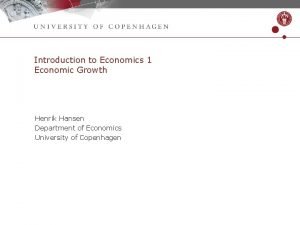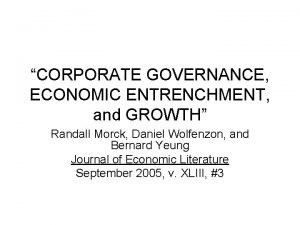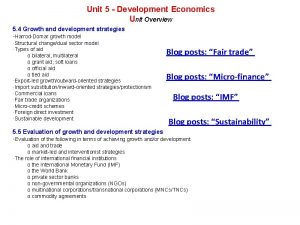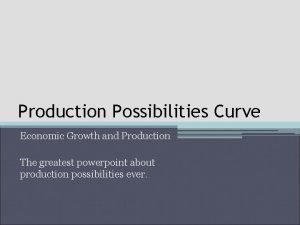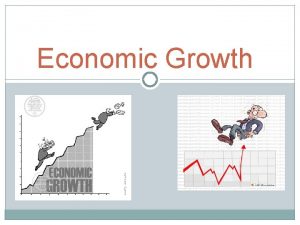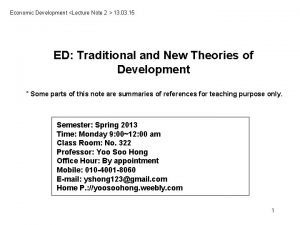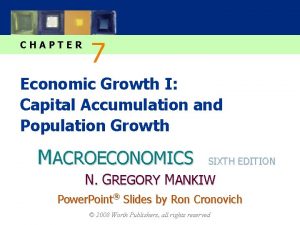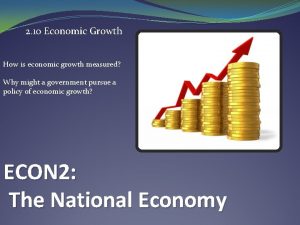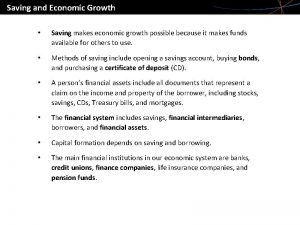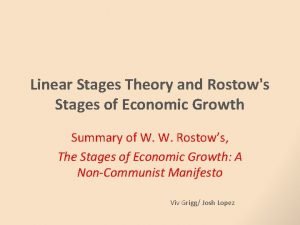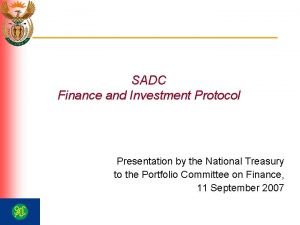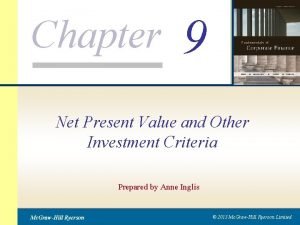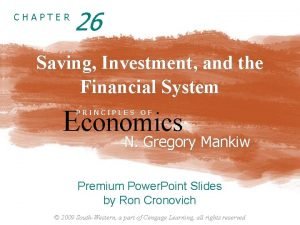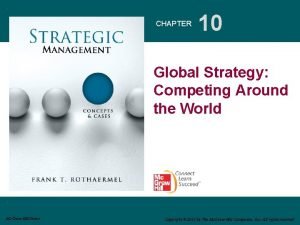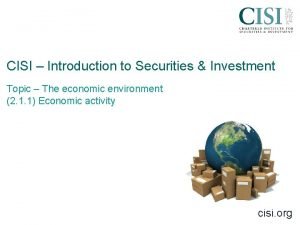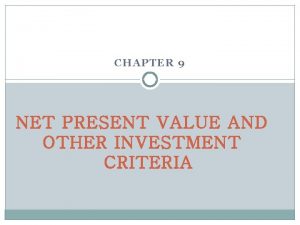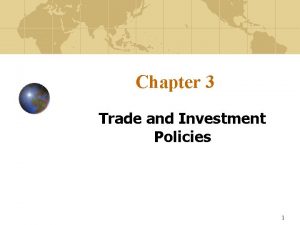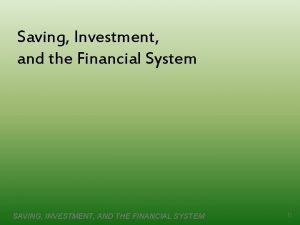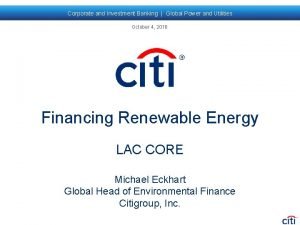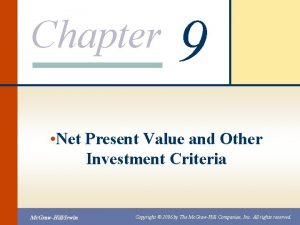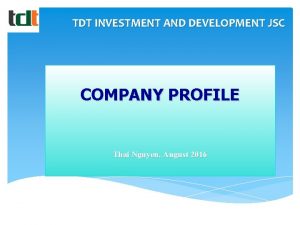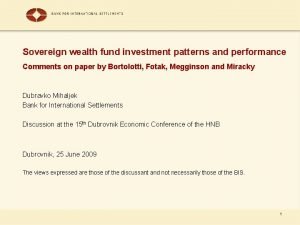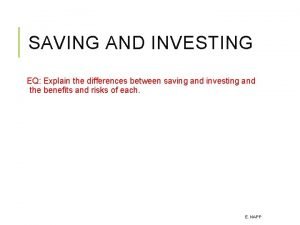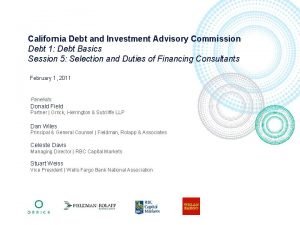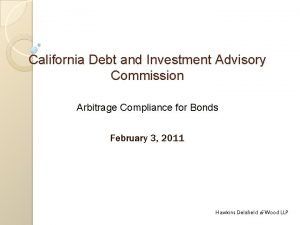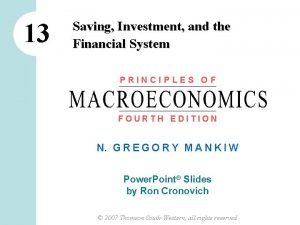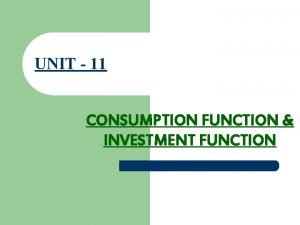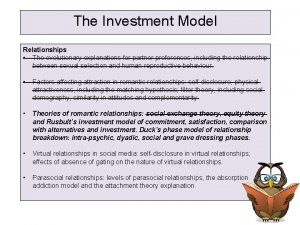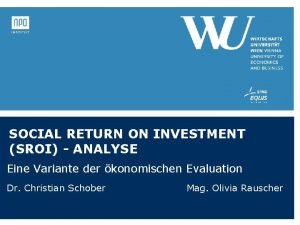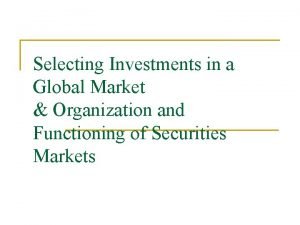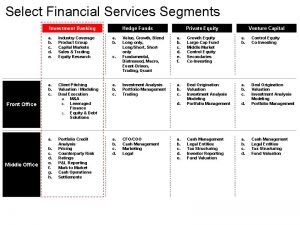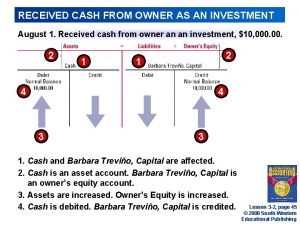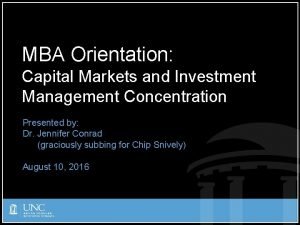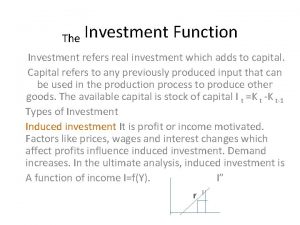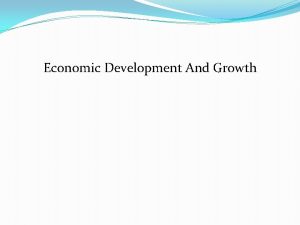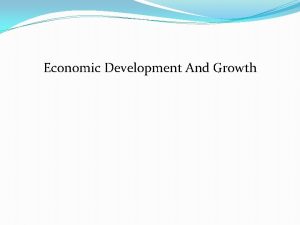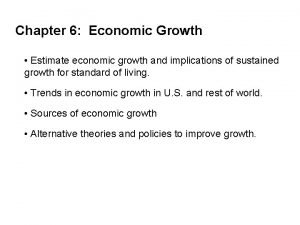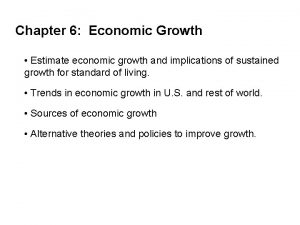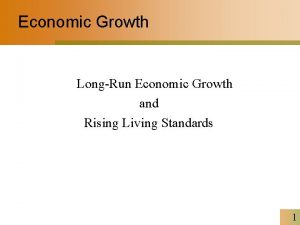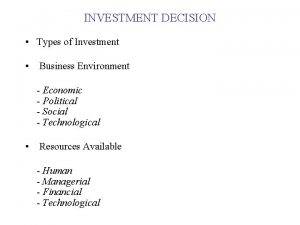ECONOMIC GROWTH AND INVESTMENT 1 ECONOMIC GROWTH AND































































































- Slides: 95

ECONOMIC GROWTH AND INVESTMENT 1

ECONOMIC GROWTH AND INVESTMENT • Improvement in the welfare of the society may be accepted as the first criterion as evaluating economies. • Although it is not easy to develop a single criterion of social welfare, we may safely say that there is a close relationship between social welfare and consumption possibilities of people. 2

ECONOMIC GROWTH AND INVESTMENT • Consumption possibilities of any society are limited by its production capacity. • The society can consume what it has produced. 3

ECONOMIC GROWTH AND INVESTMENT • The money value of social product is called national income, and an increase in national income is called economic growth. • Thus, the main way of increasing social welfare is to increase national income. • That is, social welfare is increased mainly by economic growth. 4

ECONOMIC GROWTH AND INVESTMENT • PCI is the most used measure of welfare, despite its defects. • It is calculated by dividing national income by total population of the country. • Thus, the rate of change in PCI is determined by the changes in country’s national income and total population. 5

ECONOMIC GROWTH AND INVESTMENT • In this chapter we will examine economic growth. • We will see how varying regional growth performances have changed distribution of global production capacity across regions since 1970. 6

ECONOMIC GROWTH AND INVESTMENT • We will see, also, the role of investment in economic growth. 7

ECONOMIC GROWTH 8

GDP Growth 9

GDP Growth • Economic growth is measured as the annual increase in GDP. • Existing data allow us to make some generalizations about the global growth since 1970. 10

GDP Growth • Firstly, the global growth rate has had a declining trend. • The average growth rate was 3. 86% in the first decade (1970 -1980) and this was the highest during the whole period. • The lowest growth rate is in the last decade (2010 -2019), only 2. 94%. 11

GDP Growth • Secondly, the global growth rate has displayed large fluctuations all over the period. 12

GDP Growth • Thirdly, weakening growth performance is more pronounced for developed economies especially after 1990. • While the average growth rate for the whole period is 4. 95% for developing economies, it is only 2. 50% for developed economies. 13

GDP Growth • Developed economies’ average growth rate declined steadily from 3. 35% in the 1970 s to 1. 54% in 2000 -2010 and then increased slightly to 1. 85% in 2010 -2019. • Deceleration in the growth rate of developed countries accelerated especially after 2000 and it is more evident in S. Europe and Japan. 14

GDP Growth • Fourthly, although the average growth rate for developing countries had a slightly increasing trend, there is a divergence between China and other developing countries. 15

GDP Growth • Average growth rate of developing countries excluding China has a declining trend (see, Table 4. 1 and Figure 4. 2). 16

Table 4. 1 Global Growth in the Last five Decades (%, constant 2015 -dollar prices) 197019801990200020102019 19702019 World 3. 86 3. 13 2. 98 3. 00 2. 94 3. 19 Developing economies 5. 65 3. 30 5. 03 6. 07 4. 70 4. 95 Developed economies 3. 35 3. 01 2. 70 1. 54 1. 85 2. 50 Developing Ecs excluding China 5. 60 2. 65 3. 93 4. 45 3. 22 3. 98 17

4, 0 0, 0 -2, 0 1971 1972 1973 1974 1975 1976 1977 1978 1979 1980 1981 1982 1983 1984 1985 1986 1987 1988 1989 1990 1991 1992 1993 1994 1995 1996 1997 1998 1999 2000 2001 2002 2003 2004 2005 2006 2007 2008 2009 2010 2011 2012 2013 2014 2015 2016 2017 2018 2019 Figure 4. 1 Global Growth, 1970 -2019 (%, constant 2015 -dollar prices) 7, 0 6, 4 6, 0 5, 3 0, 8 Trend 5, 0 4, 6 3, 0 1, 0 4, 5 4, 4 3, 3 2, 0 4, 5 3, 9 4, 4 3, 0 2, 8 -1, 3 3, 3 2, 7 2, 5 2, 1 1, 3 0, 4 -1, 0 18

7, 0 2, 0 0, 0 1972 1973 1974 1975 1976 1977 1978 1979 1980 1981 1982 1983 1984 1985 1986 1987 1988 1989 1990 1991 1992 1993 1994 1995 1996 1997 1998 1999 2000 2001 2002 2003 2004 2005 2006 2007 2008 2009 2010 2011 2012 2013 2014 2015 2016 2017 2018 2019 Figure 4. 2: Growth in Developing Economies, 1970 -2019 (3 -year moving average, %, constant 2015 -dollar prices) 9, 0 8, 0 Developing 6, 0 5, 0 4, 0 3, 0 Developing Economies excluding 1, 0 19

GDP Growth • As we have already seen, different regional growth performances resulted in remarkable changes in the interregional distribution of the global income since 1970. 20

GDP Growth • As the shares of the relatively low-income regions rose the share of relatively high-income regions fell. • Changes in the shares of two regions are striking: the fall in the share of Eastern Europe and the rise in the share of Eastern Asia. 21

GDP Growth • The fall in the share of Eastern Europe was resulted primarily from the collapse of the socialist regime in that region. • On the other hand, there is the rapid expansion of the Chinese economy behind the jump in the share of Eastern Asia. 22

GDP Growth • The share of China in total world GDP, in current prices, increased from 2. 7% in 1970 to 16. 2% in 2019. 23

GDP Growth • While the extraordinary growth performance of China explains about 60% of the rise in the share of Asia, the weak performance in Eastern Europe is responsible for about 69% of the fall in the share of Europe. 24

Increase in Per Capita Income 25

Increase in Per Capita Income • As we have underlined before, changes in PCI is a better indicator of improvement in the welfare of the society. • Varying performance of the regions resulted in changes in regional PCI relative to the world average. 26

Increase in Per Capita Income • Change in regional GDPs and PCIs between 1970 and 2019 is given in Table 4. 2. • When we compare regional GDP and PCI growth rates, we see the effect of increases in population, given in the second column. 27

Table 4. 2 Average Annual GDP and PCI Growth Rates, 1970 -2019 Regions AFRICA ASIA Eastern Asia South-Eastern Asia Southern Asia Western Asia EUROPE Eastern Europe Southern Europe Western Europe Northern America L. America and Car. (1970 -2019, 2015 constant prices) Population GDP Growth Rate 2. 65 3. 37 1. 62 5. 02 1. 06 5. 19 1. 76 5. 56 1. 96 4. 56 2. 73 4. 08 0. 13 2. 15 -0. 23 2. 25 0. 37 1. 99 0. 34 2. 05 0. 56 2. 42 0. 94 2. 78 1. 69 2. 95 PCI Growth Rate 0. 71 3. 35 4. 09 3. 74 2. 55 1. 33 2. 02 2. 49 1. 62 1. 70 1. 84 1. 82 28 1. 24

Increase in Per Capita Income • For example, while the African GDP increased at a higher rate than European (3. 37% versus 2. 15%), the rate of increase in African PCI is lower than European (0. 71% versus 2. 02%), because the rate of increase in African population is much higher than the European (2. 65% versus 0. 13%). 29

Increase in Per Capita Income • The best performer region is Eastern Asia; its relative PCI more than tripled from 36% of world average to 116%. • Eastern Asia was followed by South-Eastern Asia, which improved its relative position from 14% of the world average to 42%. 30

Increase in Per Capita Income • But this region is still very poor relative to the world average. • European sub-regions, excluding Eastern Europe, also improved their relative positions. 31

Increase in Per Capita Income • The best performer in Europe is Northern Europe, which has improved its position from 289% of the world average to 408%. • There is no remarkable change in the relative position of Northern America. • The LAC improved from 69% of the world average in 1970 to 76% in 2019. 32

Increase in Per Capita Income • The losers of this period are Africa and Eastern Europe. • While the average African PCI was more than one-third of the world average in 1970 (35%) it was about one-sixth in 2019 (17%). 33

Increase in Per Capita Income • Africa is the poorest among all regions that we examine. • Relative PCI in Eastern Europe fell drastically from 167% of the world average in 1970 to 100% in 2019. • Southern Asia is the second poorest region. • Its PCI was 14% of the world average in 1970 and became 20% in 2019, slightly improving. 34

Increase in Per Capita Income • Starting from GDP and PCI figures it is possible to say that the income or welfare gap between developed and developing countries has been narrowed in the last 50 years. • But the divergence between Asian and other regional performances remind us that we should be cautious on this matter. 35

Increase in Per Capita Income • Asia as a whole and all Asian sub-regions except West Asia performed better than the developed countries. • The convergence happened between developing Asia (excluding West Asia) and developed countries, not between all developing regions and developed countries. 36

Increase in Per Capita Income • Increases in PCI for developing countries excluding three Asian sub-regions (East, South-East and South Asia) have been weaker than developed countries. • Thus, the last 50 years has been the Asian Age, especially the East Asian Age. 37

INVESTMENT 38

ECONOMIC GROWTH • There are many factors influencing the growth performance of countries, such as – natural resource endowment, – technological progress, – improvement in education, – geographic position, – investment, – socio-political conditions, etc. 39

ECONOMIC GROWTH • Most of these factors are not independent of each other, they interact. • Additionally, it is not easy to measure some of them. • But investment is measurable and is one of the critical factors influencing economic growth of countries. 40

Why is Investment Important? 41

Why is Investment Important? • Investment is the first step in the cyclical process of production, income, and consumption. • It has a significant role in the rise and fall of the overall economy. 42

Why is Investment Important? • Investment in this context is an expenditure on buildings, machinery and equipment, other tangible tools, and knowledge and technology used in production. 43

Why is Investment Important? • The biggest part of investment is made in fixed capital. • Fixed capital investment includes investment in machinery and equipment, and structures such as buildings, factories, offices, pipelines. 44

Why is Investment Important? • However, investment in knowledge and technology plays a critical role in developing technology and raising productivity. 45

Why is Investment Important? • Investment is made by private business, government, and households. 46

Why is Investment Important? • Of all these investment flows, private fixed investment is the largest. • The initial investment decision by a private profit-making firm is the first step of its activities. 47

Why is Investment Important? • Governments invest mostly in public infrastructure and in the facilities used by public enterprises, like utilities or schools. • Households or individuals make investment in their own homes. 48

Why is Investment Important? • We have understood the significance of economic growth for societies, in the previous section. • The main way of increasing national welfare is to increase production possibilities of the society. 49

Why is Investment Important? • And, society’s production possibilities may be increased only by enhancing production, or by economic growth. • The production capacity of the society is enlarged by investment. 50

Why is Investment Important? • Sustainable industrial catch-up and acceleration of structural transformation require a high rate of investment in productive capacity and technological capabilities for several reasons. • First, firms need to increase their productive capacity to benefit from static scale economies. 51

Why is Investment Important? • Second, efficiency gains that can result from improved allocation of factors of production and competition among manufacturing subsectors depend on the extent to which existing firms thrive and new firms emerge. • This process is not possible without investment in new machinery and equipment. 52

Why is Investment Important? • Third, productivity gains depend to a large extent on the introduction of new technologies that are embodied in machinery and equipment, which necessitates the periodic replacement of outdated machinery and equipment. 53

Why is Investment Important? • These firm-level requirements add up to the need to increase investment rates and achieve some minimum level of per capita investment in the whole economy. 54

Why is Investment Important? • Public investment is of particular importance in crucial areas such as transport and logistics and telecommunications infrastructure, and the provision of power and water and other related utilities. 55

Why is Investment Important? • Investment in these areas indirectly boosts the productivity of economic activities in all sectors and helps accelerate the pace of structural transformation. 56

Regional Fixed Capital Investment and Growth 57

Regional Fixed Capital Investment and Growth • Regional gross capital formation figures as a ratio of GDP and annual average growth rates between 1970 and 2017 are given in Table 4. 3. • Growth rates are generally higher in regions where the investment rates also are relatively high. 58

Table 4. 3 Fixed Capital Investment and GDP Growth, 1970 -2017 Fixed Investment/GDP Ratio (%)1 (I) GDP Growth Rate (%)1(II) Capital Output Ratio (COR) (I/II)1 1. Eastern Asia 32. 16 1. South-Eastern Asia 5. 63 1. Eastern Europe 13. 99 2. Eastern Europe 31. 34 2. Eastern Asia 4. 58 2. Southern Europe 10. 55 3. Middle Africa 27. 68 3. Southern Asia 4. 51 3. Western Europe 10. 47 4. Northern Africa 27. 67 4. Western Asia 4. 22 4. Middle Africa 9. 99 5. S. -Eastern Asia 27. 14 5. Western Africa 4. 06 5. Northern Europe 7. 74 6. Southern Asia 25. 67 6. Eastern Africa 4. 03 6. Northern Africa 7. 28 7. Eastern Africa 22. 09 7. Northern Africa 3. 80 7. Southern Africa 7. 07 8. Western Europe 21. 77 8. Central America 3. 31 8. Northern America 7. 04 9. Southern Europe 21. 20 8. South America 3. 09 9. Eastern Asia 7. 02 10. Central America 20. 88 9. Northern America 2. 79 10. Central America 6. 31 11. Western Asia 20. 07 10. Middle Africa 2. 77 11. South America 6. 17 12. Northern America 19. 63 11. Southern Africa 2. 56 12. Southern Asia 5. 69 13. South America 19. 05 12. Northern Europe 2. 45 13. Eastern Africa 5. 48 14. Northern Europe 18. 97 13. Eastern Europe 2. 24 14. S. -Eastern Asia 4. 82 15. Southern Africa 18. 09 14. Western Europe 2. 08 15. Western Asia 16. Western Africa 17. 66 15. Southern Europe 2. 01 16. Western Africa 59 4. 76 4. 35

Regional Fixed Capital Investment and Growth • The top 6 regions growing relatively faster are included also in the top 10 regions with high fixed investment/GDP ratios; Eastern Asia, Northern Africa, South Eastern Asia, Southern Asia, Eastern Africa and Central America. 60

Regional Fixed Capital Investment and Growth • The highest average fixed capital investment ratio is in Eastern Asia (32. 16%), and its average growth rate is the second behind South-Eastern Asia, 4. 58% and 5. 63% respectively. • Eastern Europe’s average annual fixed capital ratio is the second behind Eastern Asia, but its average growth rate is one of the lowest. 61

Regional Fixed Capital Investment and Growth • Eastern Europe is an exception for the fixed capital investment ratio-GDP growth relation because its total GDP declined by about 70% in transition period (1990 -1998). • If we let Eastern Europe aside, there is a correlation of 0. 49 between the fixed capital investment and economic growth. 62

Regional Fixed Capital Investment and Growth • Southern Europe has the lowest growth performance, 2. 01%. • Average growth rate is relatively low also in leading developed regions; 2. 08% in Western Europe, 2. 45% in Northern Europe, and 2. 79% in Northern America. 63

Regional Fixed Capital Investment and Growth • The relationship between the investment ratio and growth rate is given in the last column and defined as the capital output ratio (COR). • COR tells us the fixed investment as a percentage of GDP necessary for a one percentage point increase in GDP. 64

Regional Fixed Capital Investment and Growth • COR is determined by three factors: – the share of investment in machinery and equipment in total fixed capital investment, – how capital-intensive is the investment – and how efficiently the existing capital stock is used. 65

Regional Fixed Capital Investment and Growth • At the beginning of the industrialization process, investment is generally less capital intensive (more labor intensive), and COR is relatively low. • That is, the percentage of fixed capital investment necessary for a percentage point of growth is relatively low. 66

Regional Fixed Capital Investment and Growth • Investment in knowledge and technology, other than investment in fixed capital, also, strongly contributes the efficiency in the usage of the fixed capital. 67

Regional Fixed Capital Investment and Growth • We see this pattern in Table 4. 3: COR is relatively higher in developed countries than developing countries. 68

Regional Fixed Capital Investment and Growth • For example, COR is 7. 74 in Northern Europe, 10. 55 in Southern Europe, 10. 47 in Western Europe, and 7. 04 in Northern America. 69

Regional Fixed Capital Investment and Growth • It is between 4. 35 and 9. 99 in African regions, 4. 82 in South Eastern Asia, 5. 69 in Southern Asia, and 4. 76 in Western Asia. 70

Regional Fixed Capital Investment and Growth • Since Eastern Asia includes Japan and is more developed; its investment is more capital intensive relative to South-Eastern and South Asia, and COR is also higher (7. 2). 71

Investment in Knowledge and Technology 72

Investment in Knowledge and Technology • Employment by skill may be used as a proxy for the investment in knowledge and research and development (R&D) expenditures may be used as a proxy for the investment in technology. 73

Investment in Knowledge and Technology • Table 4. 4 indicates that there is a close relationship between income and skill level of countries; employment skill and income move together. 74

Table 4. 4 Employment by Skill and Income Level (2020) Income Level Low Skill Medium Skill High Skill Total Civil E. Low-Income Countries 67. 9 26. 2 5. 9 100. 0 Lower Middle-Income Cs 47. 9 36. 0 16. 1 100. 0 Upper Middle-Income Cs 31. 1 48. 4 20. 5 100. 0 High-Income Countries 11. 7 46. 4 41. 9 100. 0 75

Investment in Knowledge and Technology • In 2020, while the share of the low-skill employment in total civil employment is 67. 9% for low-income countries, it is only 11. 7% for high-income countries. 76

Investment in Knowledge and Technology • On the other hand, the share of high-skill employment is only 5. 9% in low-income countries while it is 41. 9% in high-income countries. • Middle-income countries take place between these two ends of the spectrum. 77

Investment in Knowledge and Technology • Table 4. 5 indicates a similar relationship between (R&D) expenditures and income level. 78

Table 4. 5: (R&D) expenditures as a Percentage of GDP, 2017 Income Level (R&D) expenditures/GDP Ratio Least developed Countries 0. 20 Low-Income Countries 0. 29 Lower Middle-Income Countries 0. 43 Upper Middle-Income Countries 1. 48 High-Income Countries 2. 42 79

Investment in Knowledge and Technology • The relative (R&D) expenditures in high-income countries is more than 12 times of the least-developed countries. 80

Investment in Knowledge and Technology • When the big difference between the GDP level of country groups is taken account, it is seen that there is a huge gap between the (R&D) expenditures of poor and rich counties. 81

CONCLUDING REMARKS 82

CONCLUDING REMARKS • In this chapter, we have discussed the significance of investment and economic growth; and made an overview of the developments regarding these topics since 1970. 83

CONCLUDING REMARKS • We underlined their role for social welfare. • Investment enhances production capacity and therefore consumption possibilities of the society. • An increase in social product (national income) is called economic growth. 84

CONCLUDING REMARKS • Economic growth is the main way of increasing social welfare and investment plays a critical role for economic growth. 85

CONCLUDING REMARKS • We have seen that developing economies’ growth performance was generally better than developed countries since 1970. • Among developing regions Eastern, South-Eastern and Southern Asia reached the highest investment and growth rates. 86

CONCLUDING REMARKS • However, despite some improvements in the positions of developing countries, high-income countries still have the lion’s share in total global product: 63% in 2019 (Figure 1. 1). 87

CONCLUDING REMARKS • When we consider relative regional PCI, the gap between poor and rich countries could have not been narrowed. • There are hundred million of people living especially in Africa and South Asia whose average income is about 3% of Northern America (Figure 2. 2). 88

CONCLUDING REMARKS • Economic development and structural transformation need a strong investment push. • The broad sweep of history suggests that such a push is becoming more demanding the later countries begin to industrialize. 89

CONCLUDING REMARKS • Over the past five decades, productivity has grown the fastest in developing regions where the investment to-GDP ratio and investment per capita were the highest, or where investment growth was the fastest. 90

CONCLUDING REMARKS • In leading developed economies (France, Germany, Japan, the United Kingdom and the United States), while average investment as a percentage of GDP (excluding construction) fell steadily from around 20% in 1980 to historically low levels of below 16% in 2015, profit shares followed the exact opposite trajectory, rising from an average 14. 6% in 1980 to about 18% in 2013. 91

CONCLUDING REMARKS • In these economies, conventional “retain and invest” strategies have been progressively replaced by the mantra to “downsize and distribute”. • As a result, the profit-investment nexus has steadily weakened. 92

CONCLUDING REMARKS • Meanwhile, in some large developing economies, such as in Brazil, Malaysia, the Republic of Korea and Turkey investment-to-profit ratios declined sharply between 1995 and 2014. • The share of payouts is on the increase despite roughly stable profits. 93

CONCLUDING REMARKS • Firms in this category are also accumulating financial assets, indicating both a lack of profitable long-term investment opportunities as well as greater portfolio investment choices in liberalized financial markets. 94

CONCLUDING REMARKS • As a result of this general weakness in investment global growth rate has not been enough especially since the global crisis in 2009 for removing poverty and convergence of developing countries to high-income countries. 95
 Economic growth and development
Economic growth and development Fixed investment and inventory investment
Fixed investment and inventory investment Economic growth vs economic development
Economic growth vs economic development Aswath damodaran value investing
Aswath damodaran value investing Relative growth rate equation
Relative growth rate equation Monocot vs eudicot
Monocot vs eudicot Primary growth and secondary growth in plants
Primary growth and secondary growth in plants Vascular ray
Vascular ray Ssema
Ssema Economic growth and development
Economic growth and development Combination of inflation and unmoving economic growth
Combination of inflation and unmoving economic growth Corporate governance and economic growth
Corporate governance and economic growth Growthchain
Growthchain Geometric growth population
Geometric growth population Neoclassical growth theory vs. endogenous growth theory
Neoclassical growth theory vs. endogenous growth theory Organic vs inorganic growth
Organic vs inorganic growth Harrod domar model
Harrod domar model Solow's model of economic growth
Solow's model of economic growth Ppc curve economic growth
Ppc curve economic growth Long run economic growth
Long run economic growth Long run economic growth
Long run economic growth Rostow's development model
Rostow's development model Solow model of economic growth
Solow model of economic growth Solow's model of economic growth
Solow's model of economic growth Short run economic growth graph
Short run economic growth graph Real business cycle theory
Real business cycle theory Why is economic growth important
Why is economic growth important Brazil's quest for economic growth
Brazil's quest for economic growth Economic growth is defined as
Economic growth is defined as Economic growth is defined as
Economic growth is defined as Economic growth occurs when
Economic growth occurs when Rostow stages of economic growth ppt
Rostow stages of economic growth ppt Economic growth trends
Economic growth trends Saving makes economic growth possible because
Saving makes economic growth possible because Linear stages theory
Linear stages theory Lesson 2 our economic choices
Lesson 2 our economic choices Interlanguage and social identity and investment
Interlanguage and social identity and investment Stylistic continuum
Stylistic continuum Foreign direct investment advantages and disadvantages
Foreign direct investment advantages and disadvantages Sadc protocol on finance and investment
Sadc protocol on finance and investment Bdl pharma
Bdl pharma Greenfield investment
Greenfield investment Investment banking functions
Investment banking functions Direct investment and collaborative strategies
Direct investment and collaborative strategies Net present value and other investment criteria
Net present value and other investment criteria Chapter 6 - theories of international trade and investment
Chapter 6 - theories of international trade and investment Chapter 26 saving investment and the financial system
Chapter 26 saving investment and the financial system Foreign direct investment advantages and disadvantages
Foreign direct investment advantages and disadvantages Finance and investment cycle
Finance and investment cycle Apex brasil miami
Apex brasil miami Export marketing and investment assistance
Export marketing and investment assistance Cisi introduction to securities and investment
Cisi introduction to securities and investment Advantage and disadvantage of npv
Advantage and disadvantage of npv Antidumping laws
Antidumping laws What is national savings
What is national savings Investment banker career path
Investment banker career path Primary and secondary objectives of investment
Primary and secondary objectives of investment Slip casting advantages and disadvantages
Slip casting advantages and disadvantages Greenfield advantages
Greenfield advantages Investment analysis and portfolio management
Investment analysis and portfolio management Theories of international trade and investment
Theories of international trade and investment Corporate financing and investment decisions
Corporate financing and investment decisions Power and utilities investment banking
Power and utilities investment banking Difference between investment and consumption
Difference between investment and consumption Npv profiles
Npv profiles Chapter 9 net present value and other investment criteria
Chapter 9 net present value and other investment criteria Finance and investment cycle
Finance and investment cycle Investments and securities tribunal
Investments and securities tribunal Tdt investment and development jsc
Tdt investment and development jsc Sovereign wealth fund investment patterns and performance
Sovereign wealth fund investment patterns and performance What are the functions of securities firms
What are the functions of securities firms Explain the investment poem concerning stocks and bonds.
Explain the investment poem concerning stocks and bonds. Advantages and disadvantages of brownfield sites
Advantages and disadvantages of brownfield sites Scope of investment analysis and portfolio management
Scope of investment analysis and portfolio management Investment analysis and portfolio management course
Investment analysis and portfolio management course California debt and investment advisory commission
California debt and investment advisory commission California debt and investment advisory commission
California debt and investment advisory commission Saving investment and the financial system
Saving investment and the financial system Get guaranteed education tuition
Get guaranteed education tuition Starbucks foreign direct investment case study
Starbucks foreign direct investment case study What is investment function
What is investment function Evolutionary psychology
Evolutionary psychology Criticism of accelerator theory of investment
Criticism of accelerator theory of investment Introduction to strategic hospitality technology investment
Introduction to strategic hospitality technology investment Kim vender moffat
Kim vender moffat Social return on investment beispiel
Social return on investment beispiel Al meezan investment
Al meezan investment Selecting investment in global market
Selecting investment in global market Investment banking products
Investment banking products Received cash from the owner as an investment
Received cash from the owner as an investment Real estate financial analysis
Real estate financial analysis Practical investment management
Practical investment management Mba investment management concentration
Mba investment management concentration Longrich pv points
Longrich pv points Energy investment phase of glycolysis
Energy investment phase of glycolysis Marginal efficiency of investment
Marginal efficiency of investment









